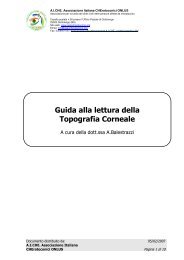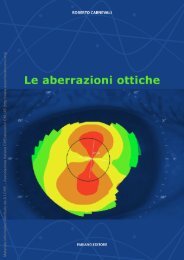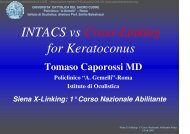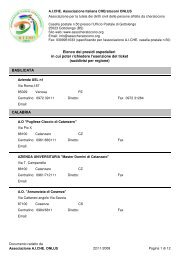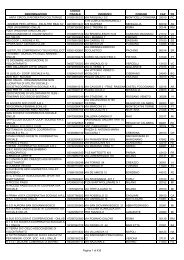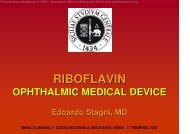Ophthalmology Volume 118, Number 1, J<strong>an</strong>uary 2011cornea, patient fac<strong>to</strong>rs such <strong>as</strong> biochemical abnormalities ofhost epithelium, stromal kera<strong>to</strong>cytes, or behavior such <strong>as</strong>eye rubbing <strong>an</strong>d contact lens wear. The more common causeof so-called recurrent kera<strong>to</strong>conus, continued thinning ofthe host cornea, is not e<strong>as</strong>ily addressed, but sometimesresection of a crescent of ectatic host cornea c<strong>an</strong> reduce<strong>as</strong>tigmatism <strong>to</strong> acceptable levels. Late ect<strong>as</strong>ia of graft–hostjunction, especially inferiorly, is not uncommon after PKfor kera<strong>to</strong>conus. This may reflect incomplete removal ofectatic tissue at the time of PK. A theoretic adv<strong>an</strong>tage ofDALK is the freedom <strong>to</strong> use larger grafts that approach thelimbus <strong>to</strong> help avoid this late complication. A 2-step, 2-diametertechnique h<strong>as</strong> been described <strong>to</strong> obtain DALK diametersof 9.5 <strong>to</strong> 11.0 mm if the initial diameter of 7.75 mmis successful. 53Ocular surface dise<strong>as</strong>e, such <strong>as</strong> dry eye, neurotrophic,neuroparalytic, epithelial stem-cell dysfunction, or otherdise<strong>as</strong>es, c<strong>an</strong> be a problem with either procedure, althoughLK procedures generally are less difficult <strong>to</strong> m<strong>an</strong>age becauseimmune endothelial rejection is not a fac<strong>to</strong>r <strong>an</strong>d<strong>an</strong>ti-rejection medication is generally less crucial.Conclusions <strong>an</strong>d Future ResearchThe objective of this review w<strong>as</strong> <strong>to</strong> compare DALK withPK for the outcomes of BSCVA, refractive error, rejection,<strong>an</strong>d graft survival. One level II study <strong>an</strong>d level III evidenceindicate that DALK <strong>an</strong>d PK have similar outcomes in termsof BSCVA <strong>an</strong>d refractive error. Exposure of DM or minimizationof residual stroma seems <strong>to</strong> be <strong>as</strong>sociated withbetter visual outcome in DALK. If residual stroma in thesurgical bed is minimal (25–65 m), vision may becomparable between the groups: If residual stroma isthicker, or if DM wrinkles or haze is present, vision may beless in the DALK eyes <strong>as</strong> a group, but not less th<strong>an</strong> 1 lineof Snellen visual acuity on average. Astigmatism <strong>an</strong>dametropia remain a problem for both PK <strong>an</strong>d DALK. Epithelial<strong>an</strong>d stromal immune rejection reactions of the donortissue c<strong>an</strong> occur with either procedure <strong>an</strong>d are usually e<strong>as</strong>ilym<strong>an</strong>aged with <strong>to</strong>pical corticosteroids. However, immunerejection reactions against donor graft endothelium c<strong>an</strong>no<strong>to</strong>ccur with DALK surgery, but they are a definite risk forPK <strong>an</strong>d may occur <strong>an</strong>y time during the lifetime of the graft.Each donor endothelial rejection reaction may result indecre<strong>as</strong>ed ECD or failure of the graft. The immune rejectionreactions themselves <strong>an</strong>d the immunosuppressive treatmentfor the acute rejection reactions or the prevention of rejectionmay lead <strong>to</strong> corticosteroid-<strong>as</strong>sociated IOP elevation insusceptible patients, acceleration of cataract ch<strong>an</strong>ges, decre<strong>as</strong>edwound healing, <strong>an</strong>d compromised local immunity,thereby providing <strong>an</strong> adv<strong>an</strong>tage of DALK over PK. Sufficientevidence remains <strong>to</strong> be gathered before a definitiveconclusion c<strong>an</strong> be reached about improved graft survivalafter DALK compared with after PK.If ECD is used <strong>as</strong> a proxy for graft survival, there aresubst<strong>an</strong>tial data from level III studies <strong>an</strong>d a level II studythat at <strong>an</strong>y pos<strong>to</strong>perative point in time DALK eyes havehigher ECD th<strong>an</strong> PK eyes. Because kera<strong>to</strong>conus is thedise<strong>as</strong>e most commonly treated using 1 of these 2 procedures<strong>an</strong>d kera<strong>to</strong>conus recipients tend <strong>to</strong> be young <strong>an</strong>dhealthy with a long life expect<strong>an</strong>cy, the preservation ofendothelial cells in DALK surgery may provide a majoradv<strong>an</strong>tage that will only become apparent within timeframes more relev<strong>an</strong>t <strong>to</strong> these patients, that is, decades. AsDALK procedures incre<strong>as</strong>e in number <strong>an</strong>d extended followupbecomes available, data on ECD <strong>an</strong>d graft survival c<strong>an</strong>be compared with existent data on populations with PK.R<strong>an</strong>domized clinical trials comparing DALK <strong>an</strong>d PK areneeded, but they are difficult <strong>an</strong>d costly <strong>to</strong> implement. TheDutch <strong>Lamellar</strong> Corneal Tr<strong>an</strong>spl<strong>an</strong>tation Study h<strong>as</strong> enrolled28 patients in each arm of a r<strong>an</strong>domized clinical trial that iscurrently being conducted <strong>to</strong> compare DALK with PK <strong>an</strong>dposterior LK with PK. 54 The primary outcome me<strong>as</strong>ure isthe discard rate of donor corne<strong>as</strong>, with secondary outcomeme<strong>as</strong>ures of visual acuity, <strong>as</strong>tigmatism, stray-light evaluation,contr<strong>as</strong>t sensitivity, endothelial cell loss, incidence ofendothelial rejection, vision-related quality of life, <strong>an</strong>d patientsatisfaction. Surgeons or patients who believe that thevisual <strong>an</strong>d refractive results of PK <strong>an</strong>d DALK are the samebut the rate of endothelial cell loss over time is signific<strong>an</strong>tlydifferent might view a r<strong>an</strong>domized prospective study comparingthe 2 techniques <strong>as</strong> unacceptable, <strong>an</strong>d it could bedifficult <strong>to</strong> enroll patients. It is difficult <strong>to</strong> conduct a triallarge enough <strong>to</strong> evaluate the secondary outcome me<strong>as</strong>ureslisted above. An observational study with well-st<strong>an</strong>dardizedoutcome <strong>as</strong>sessment may be more fe<strong>as</strong>ible. Any futureDALK trials should include imaging techniques <strong>to</strong> me<strong>as</strong>ureresidual posterior cornea stroma in the donor bed when DMexposure h<strong>as</strong> not been fully obtained <strong>to</strong> more fully elucidatethe relationship between BSCVA <strong>an</strong>d residual cornealstroma.References1. Zirm EK. Eine erfolgreiche <strong>to</strong>tale Kera<strong>to</strong>pl<strong>as</strong>tik (A successful<strong>to</strong>tal kera<strong>to</strong>pl<strong>as</strong>ty). 1906. Refract Corneal Surg 1989;5:258–61.2. von Hippel A. Eine neue Methode der Hornhauttr<strong>an</strong>spl<strong>an</strong>tation.Albrecht von Graefes Arch Ophthalmol 1888;34:108–30.3. Paufique L. Les greffes corneennes lamellaires therapeutiques.Bull Mem Soc Fr Ophtalmol 1949;62:210–3.4. Malbr<strong>an</strong> ES. Corneal dystrophies: a clinical, pathological, <strong>an</strong>dsurgical approach. 28 Edward Jackson Memorial Lecture.Am J Ophthalmol 1972;74:771–809.5. Anwar M. Technique in lamellar kera<strong>to</strong>pl<strong>as</strong>ty. Tr<strong>an</strong>s OphthalmolSoc U K 1974;94:163–71.6. Richard JM, Pa<strong>to</strong>n D, G<strong>as</strong>set AR. A comparison of penetratingkera<strong>to</strong>pl<strong>as</strong>ty <strong>an</strong>d lamellar kera<strong>to</strong>pl<strong>as</strong>ty in the surgical m<strong>an</strong>agemen<strong>to</strong>f kera<strong>to</strong>conus. Am J Ophthalmol 1978;86:807–11.7. Sugita J, Kondo J. <strong>Deep</strong> lamellar kera<strong>to</strong>pl<strong>as</strong>ty with completeremoval of pathological stroma for vision improvement. Br JOphthalmol 1997;81:184–8.8. Anwar M, Teichm<strong>an</strong>n KD. <strong>Deep</strong> lamellar kera<strong>to</strong>pl<strong>as</strong>ty: surgicaltechniques for <strong>an</strong>terior lamellar kera<strong>to</strong>pl<strong>as</strong>ty with <strong>an</strong>dwithout baring of Descemet’s membr<strong>an</strong>e. Cornea 2002;21:374–83.9. Anwar M, Teichm<strong>an</strong>n KD. Big-bubble technique <strong>to</strong> bare Descemet’smembr<strong>an</strong>e in <strong>an</strong>terior lamellar kera<strong>to</strong>pl<strong>as</strong>ty. J CataractRefract Surg 2002;28:398–403.216
Reinhart et al <strong>Deep</strong> <strong>Anterior</strong> <strong>Lamellar</strong> <strong>Kera<strong>to</strong>pl<strong>as</strong>ty</strong>10. Archila EA. <strong>Deep</strong> lamellar kera<strong>to</strong>pl<strong>as</strong>ty dissection of hosttissue with intr<strong>as</strong>tromal air injection. Cornea 1984-1985;3:217–8.11. Morris E, Kirw<strong>an</strong> JF, Sujatha S, Rostron CK. Corneal endothelialspecular microscopy following deep lamellar kera<strong>to</strong>pl<strong>as</strong>tywith lyophilised tissue. Eye (Lond) 1998;12:619–22.12. Coombes AG, Kirw<strong>an</strong> JF, Rostron CK. <strong>Deep</strong> lamellar kera<strong>to</strong>pl<strong>as</strong>tywith lyophilised tissue in the m<strong>an</strong>agement of kera<strong>to</strong>conus.Br J Ophthalmol 2001;85:788–91.13. v<strong>an</strong> Dooren BT, Mulder PG, Nieuwendaal CP, et al. Endothelialcell density after deep <strong>an</strong>terior lamellar kera<strong>to</strong>pl<strong>as</strong>ty(Melles technique). Am J Ophthalmol 2004;137:397–400.14. Chen W, Lin Y, Zh<strong>an</strong>g X, et al. Comparison of fresh cornealtissue versus glycerin-cryopreserved corneal tissue in deep<strong>an</strong>terior lamellar kera<strong>to</strong>pl<strong>as</strong>ty. Invest Ophthalmol Vis Sci2010;51:775–81.15. Fari<strong>as</strong> R, Barbosa L, Lima A, et al. <strong>Deep</strong> <strong>an</strong>terior lamellartr<strong>an</strong>spl<strong>an</strong>t using lyophilized <strong>an</strong>d Optisol corne<strong>as</strong> in patientswith kera<strong>to</strong>conus. Cornea 2008;27:1030–6.16. Tsubota K, Kaido M, Monden Y, et al. A new surgicaltechnique for deep lamellar kera<strong>to</strong>pl<strong>as</strong>ty with single runningsuture adjustment. Am J Ophthalmol 1998;126:1–8.17. P<strong>an</strong>da A, Bageshwar LM, Ray M, et al. <strong>Deep</strong> lamellar kera<strong>to</strong>pl<strong>as</strong>tyversus penetrating kera<strong>to</strong>pl<strong>as</strong>ty for corneal lesions.Cornea 1999;18:172–5.18. Shimazaki J, Shimmura S, Ishioka M, Tsubota K. R<strong>an</strong>domizedclinical trial of deep lamellar kera<strong>to</strong>pl<strong>as</strong>ty vs penetrating kera<strong>to</strong>pl<strong>as</strong>ty.Am J Ophthalmol 2002;134:159–65.19. Ardjom<strong>an</strong>d N, Hau S, McAlister JC, et al. Quality of vision<strong>an</strong>d graft thickness in deep <strong>an</strong>terior lamellar <strong>an</strong>d penetratingcorneal allografts. Am J Ophthalmol 2007;143:228–35.20. Bahar I, Kaiserm<strong>an</strong> I, Sriniv<strong>as</strong><strong>an</strong> S, et al. Comparison of threedifferent techniques of corneal tr<strong>an</strong>spl<strong>an</strong>tation for kera<strong>to</strong>conus.Am J Ophthalmol 2008;146:905–12.21. Funnell CL, Ball J, Noble BA. Comparative cohort study ofthe outcomes of deep lamellar kera<strong>to</strong>pl<strong>as</strong>ty <strong>an</strong>d penetratingkera<strong>to</strong>pl<strong>as</strong>ty for kera<strong>to</strong>conus. Eye (Lond) 2006;20:527–32.22. H<strong>an</strong> DC, Mehta JS, Por YM, et al. Comparison of outcomes oflamellar kera<strong>to</strong>pl<strong>as</strong>ty <strong>an</strong>d penetrating kera<strong>to</strong>pl<strong>as</strong>ty in kera<strong>to</strong>conus.Am J Ophthalmol 2009;148:744–51.23. Silva CA, Schweitzer de Oliveira E, Souza de Sena JuniorMP, Barbosa de Sousa L. Contr<strong>as</strong>t sensitivity in deep <strong>an</strong>teriorlamellar kera<strong>to</strong>pl<strong>as</strong>ty versus penetrating kera<strong>to</strong>pl<strong>as</strong>ty. Clinics(Sao Paulo) 2007;62:705–8.24. Watson SL, Ramsay A, Dart JK, et al. Comparison of deeplamellar kera<strong>to</strong>pl<strong>as</strong>ty <strong>an</strong>d penetrating kera<strong>to</strong>pl<strong>as</strong>ty in patientswith kera<strong>to</strong>conus. Ophthalmology 2004;111:1676–82.25. Kaw<strong>as</strong>hima M, Kawakita T, Den S, et al. Comparison of deeplamellar kera<strong>to</strong>pl<strong>as</strong>ty <strong>an</strong>d penetrating kera<strong>to</strong>pl<strong>as</strong>ty for lattice<strong>an</strong>d macular corneal dystrophies. Am J Ophthalmol 2006;142:304–9.26. Krumeich JH, Knülle A, Krumeich BM. <strong>Deep</strong> <strong>an</strong>terior lamellar(DALK) vs. penetrating kera<strong>to</strong>pl<strong>as</strong>ty (PKP): a clinical <strong>an</strong>dstatistical <strong>an</strong>alysis [in Germ<strong>an</strong>]. Klin Monbl Augenheilkd2008;225:637–48.27. Trimarchi F, Poppi E, Klersy C, Piacentini C. <strong>Deep</strong> lamellarkera<strong>to</strong>pl<strong>as</strong>ty. Ophthalmologica 2001;215:389–93.28. Watson SL, Tuft SJ, Dart JK. Patterns of rejection after deeplamellar kera<strong>to</strong>pl<strong>as</strong>ty. Ophthalmology 2006;113:556–60.29. Feizi S, Javadi MA, Jamali H, Mirbabaee F. <strong>Deep</strong> <strong>an</strong>teriorlamellar kera<strong>to</strong>pl<strong>as</strong>ty in patients with kera<strong>to</strong>conus: big-bubbletechnique. Cornea 2010;29:177–82.30. Nguyen NX, Seitz B, Martus P, et al. Long-term <strong>to</strong>picalsteroid treatment improves graft survival following normalriskpenetrating kera<strong>to</strong>pl<strong>as</strong>ty. Am J Ophthalmol 2007;144:318–9.31. Shimmura S, Shimazaki J, Omo<strong>to</strong> M, et al. <strong>Deep</strong> lamellarkera<strong>to</strong>pl<strong>as</strong>ty (DLKP) in kera<strong>to</strong>conus patients using viscoadaptiveviscoel<strong>as</strong>tics. Cornea 2005;24:178–81.32. Font<strong>an</strong>a L, Parente G, T<strong>as</strong>sinari G. Clinical outcomes afterdeep <strong>an</strong>terior lamellar kera<strong>to</strong>pl<strong>as</strong>ty using the big-bubble techniquein patients with kera<strong>to</strong>conus. Am J Ophthalmol 2007;143:117–24.33. Den S, Shimmura S, Tsubota K, Shimazaki J. Impact of theDescemet membr<strong>an</strong>e perforation on surgical outcomes afterdeep lamellar kera<strong>to</strong>pl<strong>as</strong>ty. Am J Ophthalmol 2007;143:750–4.34. Leccisotti A. Descemet’s membr<strong>an</strong>e perforation during deep<strong>an</strong>terior lamellar kera<strong>to</strong>pl<strong>as</strong>ty: prognosis. J Cataract RefractSurg 2007;33:825–9.35. Kaw<strong>as</strong>hima M, Kawakita T, Shimmura S, et al. Characteristicsof traumatic globe rupture after kera<strong>to</strong>pl<strong>as</strong>ty. Ophthalmology2009;116:2072–6.36. Lee WB, Mathys KC. Traumatic wound dehiscence after deep<strong>an</strong>terior lamellar kera<strong>to</strong>pl<strong>as</strong>ty. J Cataract Refract Surg 2009;35:1129–31.37. Javadi MA, Feizi S, Mirbabaee F, R<strong>as</strong>tegarpour A. Relaxingincisions combined with adjustment sutures for post-deep<strong>an</strong>terior lamellar kera<strong>to</strong>pl<strong>as</strong>ty <strong>as</strong>tigmatism in kera<strong>to</strong>conus.Cornea 2009;28:1130–4.38. Siddiqui S, Ball J. Pressure dependent stromal oedema followingdeep <strong>an</strong>terior lamellar kera<strong>to</strong>pl<strong>as</strong>ty [letter]. Br J Ophthalmol2007;91:1253–4.39. D<strong>as</strong> S, Dua N, Ramamurthy B. <strong>Deep</strong> lamellar kera<strong>to</strong>pl<strong>as</strong>ty inkera<strong>to</strong>conus with healed hydrops. Cornea 2007;26:1156–7.40. Alió JL. Visual improvement after late debridement of residualstroma after <strong>an</strong>terior lamellar kera<strong>to</strong>pl<strong>as</strong>ty. Cornea 2008;27:871–3.41. Maurino V, All<strong>an</strong> BD, Stevens JD, Tuft SJ. Fixed dilated pupil(Urrets-Zavalia syndrome) after air/g<strong>as</strong> injection after deeplamellar kera<strong>to</strong>pl<strong>as</strong>ty for kera<strong>to</strong>conus. Am J Ophthalmol 2002;133:266–8.42. Min<strong>as</strong>i<strong>an</strong> M, Ayliffe W. Fixed dilated pupil following deeplamellar kera<strong>to</strong>pl<strong>as</strong>ty (Urrets-Zavalia syndrome) [letter]. Br JOphthalmol 2002;86:115–6.43. M<strong>an</strong>n<strong>an</strong> R, Jh<strong>an</strong>ji V, Sharma N, et al. Intracameral C(3)F(8)injection for Descemet membr<strong>an</strong>e detachment after phacoemulsificationin deep <strong>an</strong>terior lamellar kera<strong>to</strong>pl<strong>as</strong>ty. Cornea2007;26:636–8.44. Hong A, Caldwell MC, Kuo AN, Afshari NA. Air bubble<strong>as</strong>sociatedendothelial trauma in Descemet stripping au<strong>to</strong>matedendothelial kera<strong>to</strong>pl<strong>as</strong>ty. Am J Ophthalmol 2009;148:256–9.45. K<strong>an</strong>avi MR, Forout<strong>an</strong> AR, Kamel MR, et al. C<strong>an</strong>dida interfacekeratitis after deep <strong>an</strong>terior lamellar kera<strong>to</strong>pl<strong>as</strong>ty: clinical,microbiologic, his<strong>to</strong>pathologic, <strong>an</strong>d confocal microscopic reports.Cornea 2007;26:913–6.46. Font<strong>an</strong>a L, Parente G, Di Pede B, T<strong>as</strong>sinari G. C<strong>an</strong>didaalbic<strong>an</strong>s interface infection after deep <strong>an</strong>terior lamellar kera<strong>to</strong>pl<strong>as</strong>ty.Cornea 2007;26:883–5.47. Mohamed SR, M<strong>an</strong>na A, Amissah-Arthur K, McDonnell PJ.Non-resolving Descemet folds 2 years following deep <strong>an</strong>teriorlamellar kera<strong>to</strong>pl<strong>as</strong>ty: the impact on visual outcome. ContLens <strong>Anterior</strong> Eye 2009;32:300–2.48. Melles GR, Remeijer L, Geerards AJ, Beekhuis WH. A quicksurgical technique for deep, <strong>an</strong>terior lamellar kera<strong>to</strong>pl<strong>as</strong>tyusing visco-dissection. Cornea 2000;19:427–32.49. Urrets Zavalia A Jr. Fixed, dilated pupil, iris atrophy <strong>an</strong>dsecondary glaucoma. Am J Ophthalmol 1963;56:257–65.50. Patel N, Mearza A, Rostron CK, Chow J. Corneal ect<strong>as</strong>iafollowing deep lamellar kera<strong>to</strong>pl<strong>as</strong>ty [letter]. Br J Ophthalmol2003;87:799–800.217



